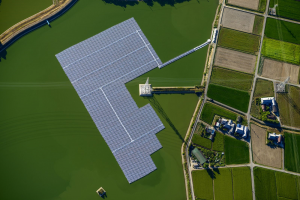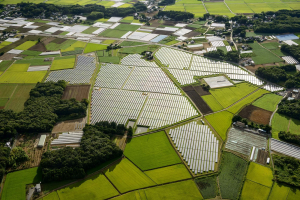Since the occurrence of the 2011 Triple Disaster, Japan has begun shifting perspectives, policies, and activities of energy production towards more alternative sources, ie. Solar, Biomass, Geothermal, etc. Of particular notice is Solar energy, which is becoming most popular and growing at an increasing rate for the past few years in Japan. Not only is Solar energy a renewable, each system has the ability to be arranged in various formations, as the panels are modular. Along with the relatively ‘cheaper’ cost of PV (photovoltaic) panels, the rise of its prevalence in Japan seems more likely due to the ‘borderless’ characteristics of Solar Farms and its ability to morph to the dynamic physical geography of Japan.

Historically, Japan has been heavily dependent on the import of fossil fuels to sustain its energy demands, due in part to the scarcity of resource deposits, such as oil and other fossil fuels, within its highly active natural landscapes. Approximately 94% of Japan’s primary energy sources are reliant on imported resources, however, global politics, cost, and transport infrastructures have increasingly made it difficult for Japan to meet its energy demands, especially after The Triple Disaster (FEPC, 2017).
Therefore, the versatility of Solar energy has proven an indispensable characteristic as it is both adaptive and response (to the Triple Disaster). Moreover, the challenges posed by highly active environments is not only shown in the production of energy, but also in the efficient and safe transport of energy to and from sources. Solar Farms can exists within the urban fabric as a dynamic interconnected matrix of energy, minimizing the overall friction of distance of energy and ultimately creating in situ energy sources; rather than larger power plants set at further distances.

Another notable feature of Solar Farms is the ability to remain connected to a grid in the case of an emergency or natural disaster. The Fukushima Nuclear Plant provided a large amount of energy for its surrounding landscape and when hit by the Tsunami was forced offline. However, if a highly integrated energy matrix existing of Solar Farms scattered across regions, the impact of energy loss might be mitigated as ample power can still be sourced from other farms or stations surrounding an area forced offline via natural disaster.
Finally, Japan’s northern regions are seemingly underutilized, which is due to its dense mountain ranges and highly active volcanic landscape. Solar Farms might flourish in these areas of Japan due to the lack of large urban cores and greater space between each city centre. Most areas North of the Kanto region and in Hokkaido are already industry laden (agriculture) which further substantiates the feasibility of increasing the number of Solar Farms in those areas. Rather, Japan might consider the development of Solar Farms in these area as a way to solidify and reorganize population densities into more (rural) Northern areas of the nation, as well as, influence the further need and use of a Shinkansen Line to Sapporo; currently not directly accessible via Shinkansen.

Sources:
Kåberger, Tomas (2017) Solar PV cheaper than LNG-power in Japan makes massive deployment possible. Retrieved from http://www.renewable-ei.org/en/column/column_20170526.php
Kimura, Keiji (2017) Solar covered 76% of a demand in Kyushu at its peak generation
The Federation of Electrical Power Companies of Japan (FEPC). (2017). Japan’s Energy Supply Situation and Basic Policy. Retrieved from http://www.fepc.or.jp/english/energy_electricity/supply_situation/index.html
Ministry of Economy, Trade, and Industry. (2017) Japan’s Energy White Paper 2017: Japan’s Energy Landscape and Key Policy Measures. Retrieved from http://www.enecho.meti.go.jp/en/category/whitepaper/pdf/whitepaper_2017.pdf
Hall, Sam., Eckhouse, Brian (2017) Japan’s Renewable-Energy Revolution. Retrieved from https://www.bloomberg.com/news/photo-essays/2017-07-13/japan-s-renewable-energy-revolution
